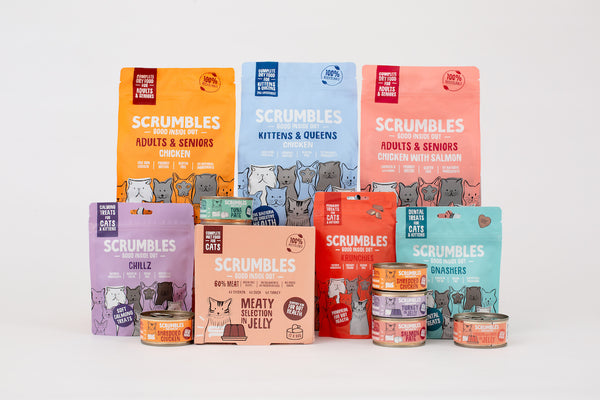Silky | Ancient | Swimmers. With their origins dating as far back as 75AD, these kitties are an ancient floofy wonder of the world. And with a unique top and tail fur pattern and love for swimming, they truly are one of a kind. Join us as we dive headfirst into the silky-haired world of the Turkish Van cat with this comprehensive cat breed guide.

TURKISH VAN CAT BASICS
Average Lifespan: 12 - 18 years
Average Weight: 4.5 - 8kg
Coat Length: Semi-long
Colouring: White with coloured head and tail
Shedding: Moderate
WHAT IS THE ANCESTRY OF THE TURKISH VAN CAT?
Turkish Van cats come from Lake Van, Turkey’s largest lake close to the Iranian border. These white silky-haired floofs with coloured fur on their head and tail have been around for thousands of years, with some archaeological evidence suggesting their origins dating as far back as 75 AD. Some even say that they trotted down from nearby Mount Ararat where Noah’s Ark came to rest, with Allah blessing them as they left the Ark by touching their heads, causing their fur to change colour.
Whichever wondrous origins story is true, the modern history of the breed began in 1954 when Laura Lushington and Sonia Halliday were travelling in Turkey whilst working for the Turkish Tourist Board. They were gifted two Turkish Van cats whom they brought back to the UK to begin producing the breed, quickly gaining popularity at cat shows due to their uniquely patterned fur and luxurious coat. From there, they gained championship status through the GCCF in 1969, however, they remain rare in the UK to do this day, with only two breeders listed by the Turkish Van Cat Club.
WHAT DO TURKISH VAN CATS LOOK LIKE?
Turkish Van cats have a medium build with semi-long silky hair. Lake Van, where these cats come from, fluctuates immensely in temperature with months of below-freezing conditions intertwined with months of scorching summery heat. With this, their coats have adapted to be a single layer which is long and silky and increases in density in the winter months, and sheds easily as the summer warms up. This makes their fur much lower maintenance than their double-coated cousins.
Their fur is snowy white with coloured markings on the head and their bushy tail which is usually auburn, but can be a whole array of differing colours and combinations. Their ears are large and pointy and their eyes sit like two beautiful jewels on their face, sparkling in either blue, amber or odd-coloured.
PURRSONALITY OF THE TURKISH VAN CAT
Turkish Van cats are an active breed who seemingly can’t keep their tufted tootsies on the floor. These guys love climbing and being at heights, so be sure to invest in a cat tower or cat tree to prevent them from using your cupboards as playthings and inadvertently knocking your prized china off the shelves!
Fascinatingly, Turkish Vans love the water, with the two original breeders witnessing their kittens swimming out at great depths in Lake Van, frolicking in the watery depths. Modern Turkish Vans are no different, and with their deep love and at times obsession with their hoomans following them wherever they lead, these guys have even been known to jump in the bath with their pawrents.
Turkish Van cats are very intelligent and don’t do well when left alone for hours so need to be stimulated with plenty of games and interactive toys or with other fur baby BFFs.
IS A TURKISH VAN CAT FRIENDLY?
Turkish Van cats are extremely friendly. They’re also confident so make friends quickly with anyone who enters their home. However, they don’t love being picked up and handled immensely. They do enjoy cuddles with their pawrents from time to time but only when it suits them, so don’t go chasing them if they’re having some “me time”.

TURKISH VAN CAT FEEDING REQUIREMENTS
As Turkish Van cats are a natural breed of floof they’re very healthy and tend to live long into their late teens if they enjoy regular cat exercise and are fed supreme nutrition.
To ensure the cat food you choose for your Turkish Van cat is fabulous and not just fluff make sure that it:
- Contains at least 60% animal meat to provide your cat with enough animal protein to satiate the carnivore within and provide them with the essential nutrients their bodies need.
- Doesn’t contain plant proteins like pea protein as these are poorly digested by cats.
- Uses high-quality all-natural ingredients.
- Avoids artificial additives, fillers, preservatives or added salt and sugar which is unhealthy for cats.
- Is formulated to FEDIAF guidelines.
SCRUMBLES, THE PAWFECT FOOD FOR TURKISH VAN CATS

Scrumbles gut-friendly cat food kicks goals when it comes to cat nutrition, gut health and of course taste! Here’s why Turkish Van cats love our cat food:
- Our recipes contain up to 77% animal meat and we never use plant proteins like pea protein which is poorly digested by cats.
- We use gut-friendly prebiotics or probiotics to reduce smelly farts and tummy upsets and avoid common allergens like dairy, soy and egg, making our recipes highly digestible.
- All of our cat food recipes contain only 100% natural ingredients and no artificial fluff or added salt and sugar.
- Our wet cat food and dry cat food recipes are nutritionally balanced and complete and formulated to FEDIAF guidelines, providing all the essential nutrients, vitamins and minerals your Turkish Van needs to eat daily.
- Served in 100% recyclable tins and eco-friendly packaging, choosing Scrumbles for your cat won’t cost the planet.


